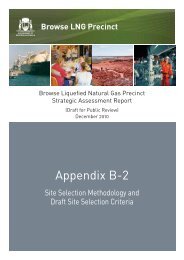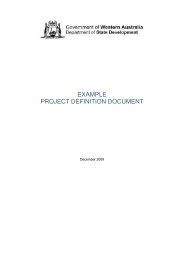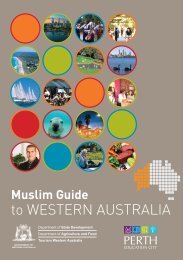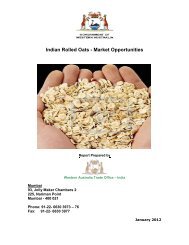Browse LNG Precinct - Public Information Booklet - Department of ...
Browse LNG Precinct - Public Information Booklet - Department of ...
Browse LNG Precinct - Public Information Booklet - Department of ...
You also want an ePaper? Increase the reach of your titles
YUMPU automatically turns print PDFs into web optimized ePapers that Google loves.
<strong>Public</strong> <strong>Information</strong> <strong>Booklet</strong><br />
Ships entering the port will need to meet all <strong>of</strong> the standard rules that apply to any ship<br />
coming into any port in Australia. This includes quarantine, immigration and customs<br />
requirements. In addition, companies such as Woodside require all ships that accept<br />
cargo from their facilities be subjected to a vessel vetting process to ensure quality ships<br />
are used and that they are compatible with the port.<br />
The open ocean approach <strong>of</strong> the ships to the Dampier Peninsula will be under the control<br />
<strong>of</strong> the ships captain. Given the location <strong>of</strong> James Price Point the ships will stay at least<br />
16 nautical miles (30 kilometres or 18 miles) <strong>of</strong>fshore <strong>of</strong> the Lacepede Islands as required<br />
by normal seafaring practices. Seafaring practices will result in the ships captain<br />
selecting a route that will stay in well surveyed and understood areas.<br />
5.5. Environmental Management<br />
Animals<br />
Questions:<br />
� What effect will the plant have on surrounding animals?<br />
� Will the light from the plant affect turtles?<br />
� What information is there about noise and its effect on calving whales?<br />
Construction <strong>of</strong> the plant and all associated infrastructure will not commence until a<br />
detailed environmental assessment is undertaken and all approvals are in place. The<br />
environmental assessment determines the level <strong>of</strong> impact on all environmental features,<br />
including the animals. Measures will be put in place to minimise impacts to an acceptable<br />
level. For example this would include designing the layout <strong>of</strong> the plant and facilities to<br />
avoid sensitive habitats where practicable, and putting in place operating procedures<br />
such as speed limits to protect the wildlife.<br />
When turtles come up to a beach to lay eggs, or hatchlings emerge from the nests, they<br />
can be disoriented by artificial lighting from buildings or other coastal development. The<br />
environmental impact assessment will identify whether there is potential for impacts from<br />
lighting. If required the plant and all infrastructure can be designed so that the lighting<br />
minimises impact on the turtles. This can be done by using particular types <strong>of</strong> lights, or<br />
shielding the lights to reduce light spill onto sensitive areas.<br />
The potential for noise from the construction activities, the <strong>LNG</strong> plant and <strong>LNG</strong> tankers<br />
will be assessed as a part <strong>of</strong> the environmental assessment process. Once the level <strong>of</strong><br />
noise is understood, studies will be undertaken with whale and marine fauna experts to<br />
determine whether the noise could impact on calving whales. If there is a risk <strong>of</strong> impacts<br />
on calving whales then measures will be put in place to reduce the risk <strong>of</strong> any impacts.<br />
This assessment will form the basis for the environmental approvals.<br />
5.6. Noise, Water and Waste Management<br />
5279225 71









